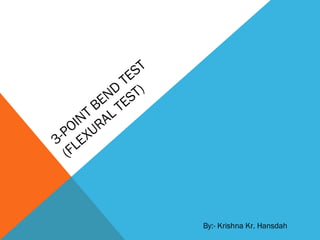
3 point bend test
- 1. ST TE D T) BEN TES INT RAL PO XU 3- L E (F By:- Krishna Kr. Hansdah
- 2. FLEXURAL TEST In engineering mechanics, flexure or bending characterizes the behavior of a slender structural element subjected to an external load applied perpendicularly to a longitudinal axis of the element. Typical Materials used for Flexural Test 1.Polymers 2.Wood And Composites 3.Brittle Materials
- 3. TYPES OF FLEXURE TESTS
- 4. WHY PERFORM A FLEXURE TEST? A flexure test produces tensile stress in the convex side of the specimen and compression stress in the concave side. This creates an area of shear stress along the midline. To ensure the primary failure comes from tensile or compression stress the shear stress must be minimized. This is done by controlling the span to depth ratio; the length of the outer span divided by the height (depth) of the specimen. For most materials S/d=16 is acceptable. Some materials require S/d=32 to 64 to keep the shear stress low enough.
- 5. The Flexural test measures the force required to bend a beam under 3-point loading conditions. The data is often used to select materials for parts that will support loads without flexing. Flexural modulus is used as an indication of a material’s stiffness when flexed.
- 6. 3-POINT BEND TEST In this test a specimen with rectangular or flat cross-section is placed on two parallel supporting pins. The loading force is applied in the middle by means loading pin. The supporting and loading pins are mounted in a way, allowing their free rotation about: -axis parallel to the pin axis; -axis parallel to the specimen axis.
- 7. It provides values for the modulus of elasticity in bending , flexural stress , flexural strain and the flexural stress-strain response of the material. Advantage -ease of the specimen preparation and testing. Disadvantage -the results of the testing method are sensitive to specimen and loading geometry and strain rate. Flexural strength or modulus of rupture -The stress required to fracture a specimen in a bend test. Flexural modulus - The modulus of elasticity calculated from the results of a bend test, giving the slope of the stress-deflection curve.
- 9. TESTING METHOD For a rectangular cross section, Calculation of the flexural stress , Calculation of the flexural strain , Calculation of flexural modulus ,
- 10. where, = Stress in outer fibers at midpoint, (MPa) = Strain in the outer surface, (mm/mm) = flexural Modulus of elasticity,(MPa) P= load at a given point on the load deflection curve, (N) L= Support span, (mm) b = Width of test beam, (mm) d= Depth of tested beam, (mm) D= maximum deflection of the center of the beam, (mm) m = The gradient (i.e., slope) of the initial straight-line portion of the load deflection curve,(P/D), (N/mm)
- 11. RESULTS
- 16. THANK YOU
